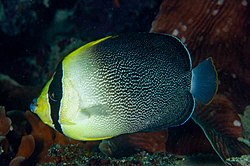| Chaetodontoplus poliourus | |
|---|---|
 | |
| Scientific classification | |
| Domain: | Eukaryota |
| Kingdom: | Animalia |
| Phylum: | Chordata |
| Class: | Actinopterygii |
| Order: | Acanthuriformes |
| Family: | Pomacanthidae |
| Genus: | Chaetodontoplus |
| Species: | C. poliourus |
| Binomial name | |
| Chaetodontoplus poliourus | |

Chaetodontoplus poliourus, the greytail angelfish, [3] is a species of marine angelfish in the class Actinopterygii. It is found in the coastal Pacific waters of Papua New Guinea, Palau, the Solomon Islands, and Indonesia.
